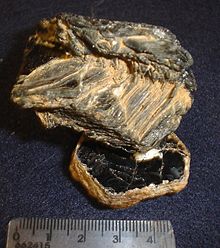Identifying Rocks and Minerals/Cleavage
Cleavage, in mineralogy, is the tendency of crystalline materials to split along definite crystallographic structural planes. These planes of relative weakness are a result of the regular locations of atoms and ions in the crystal, which create smooth repeating surfaces that are visible both in the microscope and to the naked eye.[1]

Types of cleavage
editCleavage forms parallel to crystallographic planes:[1]

- Basal or pinacoidal cleavage occurs parallel to the base of a crystal. This orientation is given by the {001} plane in the crystal lattice (see the Miller indexes page in Wikipedia), and is the same as the {0001} plane in Bravais-Miller indexes, which are often used for rhombohedral and hexagonal crystals. Basal cleavage is exhibited by the mica group and by graphite.
- Cubic cleavage occurs on the {001} planes, parallel to the faces of a cube for a crystal with cubic symmetry. This is the source of the cubic shape seen in crystals of ground table salt, the mineral halite. The mineral galena also typically exhibits perfect cubic cleavage.
- Octahedral cleavage occurs on the {111} crystal planes, forming octahedron shapes for a crystal with cubic symmetry. Diamond and fluorite exhibit perfect octahedral cleavage. Octahedral cleavage is seen in common semiconductors. For lower-symmetry crystals, there will be a smaller number of {111} planes.
- Dodecahedral cleavage occurs on the {110} crystal planes forming dodecahedra for a crystal with cubic symmetry. For lower-symmetry crystals, there will be a smaller number of {110} planes.
- Rhombohedral cleavage occur parallel to the {1011} faces of a rhombohedron. Calcite and other carbonate minerals exhibit perfect rhombohedral cleavage.
- Prismatic cleavage is cleavage parallel to a vertical prism {110}. Cerussite, tremolite and spodumene exhibit prismatic cleavage.
Parting
editCrystal parting occurs when minerals break along planes of structural weakness due to external stress or along twin composition planes. Parting breaks are very similar in appearance to cleavage, but only occur due to stress. Examples include magnetite which shows octahedral parting, the rhombohedral parting of corundum and basal parting in pyroxenes.[1]
Uses
editCleavage is a traditional physical property used in mineral identification both in hand specimen and microscopic examination of rock and mineral studies. As an example, the angles between the prismatic cleavage planes for the pyroxenes (88-92°) and the amphiboles (56-124°) are diagnostic.[1]
Crystal cleavage is of technical importance in the electronics industry and in the cutting of gemstones.
Precious stones are generally cleaved by impact as in diamond cutting.
Synthetic single crystals of semiconductor materials are generally sold as thin wafers which are much easier to cleave. Simply pressing a silicon wafer against a soft surface and scratching its edge with a diamond scribe is usually enough to cause cleavage; however, when dicing a wafer to form chips, a procedure of scoring and breaking is often followed for greater control. Elemental semiconductors (Si, germanium, and diamond) are diamond cubic, a space group for which octahedral cleavage is observed. This means that some orientations of wafer allow near-perfect rectangles to be cleaved. Most other commercial semiconductors GaAs, InSb, etc.) can be made in the related zinc blende structure, with similar cleavage planes.
References
edit- ↑ a b c d * Hurlbut, Cornelius S.; Klein, Cornelis, 1985, Manual of Mineralogy, 20th ed., Wiley, ISBN 0-471-80580-7